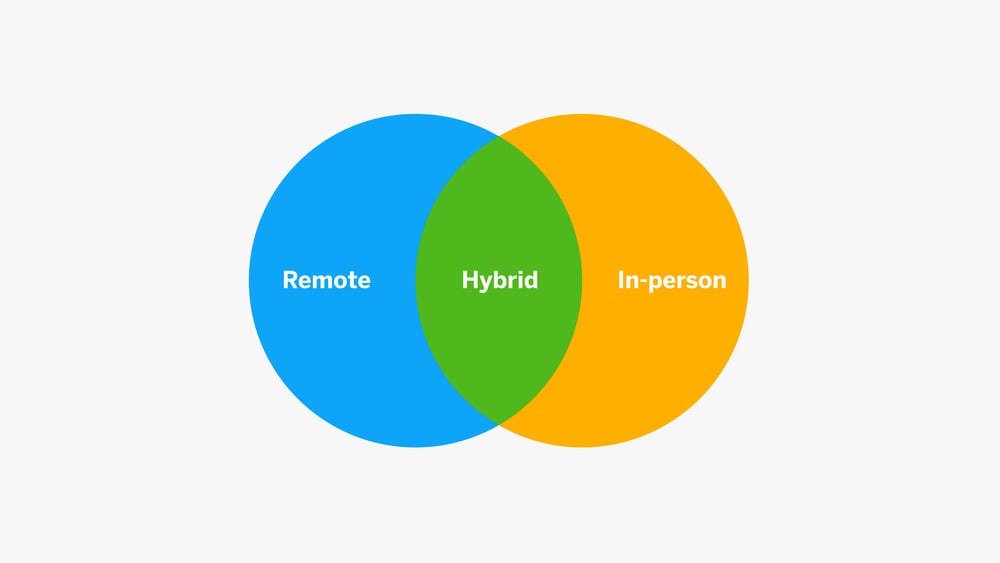What Is Hybrid Working And Hybrid Workplace Model?
Hybrid Working is the world's favorite hybrid working model in the new normal in the world, based on Microsoft's Work Trend Index survey.
The hybrid workplace model combines remote workers with on-site workers and offers flexibility to choose where and when they work.
A hybrid workplace paradigm combines in-office and remote work to provide employees with flexibility and support. Employees in a hybrid workplace often have more autonomy and a better work-life balance, and as a result, they are more engaged. Building a more productive, healthy, and stable workforce benefits employer.
However, the hybrid workplace is not a simple formula or a one-size-fits-all solution to all workplace problems. Today's hybrid workplace must be carefully deployed, leveraging modern HR technology that foster connection, collaboration, and employee engagement.
1. What is hybrid working and a hybrid workplace model?
The hybrid workplace concept mixes remote and on-site workers, with some or all employees being able to select where and when they work. Office time might be scheduled by the day, by teams, or on an as-needed basis. "Where and when work gets done," according to Gartner, "will be determined by what makes the most sense to drive the highest levels of productivity and engagement."
 Figure 1. What is hybrid?
Figure 1. What is hybrid?The hybrid approach is not appropriate for every workplace or industry; it is best suited to employees whose work is computer-based and does not require on-site performance. A recent McKinsey analysis looked at remote work that can be done without sacrificing efficiency. It was concluded that "between 20% and 25% of advanced economies' workforces could work from home three to five days per week. This is four to five times more distant work than existed prior to the outbreak."
2. Why the hybrid workplace is the developing norm.
The shift to remote and hybrid work was underway long before the pandemic, but, like with so many other things, COVID-19 expedited the process, according to VNExpress. Businesses faced a slew of issues, ranging from providing the necessary tools to managing productivity and morale in a distributed team setting. However, after a few months, it was evident that there was no turning back - staff enjoyed this new, more flexible manner of working.
Businesses can profit from lessons learnt from their remote work experiences now that some employees are re-entering regular office settings - at least some of the time. The idea is to create a hybrid work paradigm that best meets their individual requirements.
 Figure 2. Hybrid workplace is the developing norm
Figure 2. Hybrid workplace is the developing normModern HR tools are helping the transition to hybrid work by allowing data to be collected, managed, and analysed from all teams, independent of location. Technology may help with employee onboarding, upskilling, and reskilling, and it can also provide employees with access to everything they need during their employee journey, from collaboration tools to cloud technologies, when used appropriately.
The ideal "new normal" workplace is an inclusive hybrid workplace in which all employees, regardless of location, are productive, engaged, and feel connected and included.
3. Benefits of a hybrid work environment
A hybrid workplace that prioritizes the human experience takes use of developing HR technologies to become more adaptable, agile, and productive. According to Gartner, "only 36% of employees were high performers at typical organizations where employees work a standard 40 hours per week in the office." When firms transitioned from this atmosphere to one of radical flexibility, where employees could choose where, when, and how much they worked, 55% of employees performed well."
- Increased employee productivity: A variety of factors contribute to increased productivity, including increased autonomy in choosing work hours and location, fewer interruptions at home than in the office, repurposing commuting time, and the ability to come into the office when in-person collaboration is most beneficial.
- Reduced overhead costs: Businesses are examining their real estate strategy and chances to cut office space or relocate to smaller cities, all of which can reduce overhead. Employees that are hybrid are more engaged, which leads to less churn and lowers costs.
- Improved employee experience and work-life balance: Greater flexibility and autonomy promote job satisfaction and happiness, which improves work performance and overall employee well-being. A unified focus on work-life balance contributes to the success of a mixed workplace.
- Improved safety and social distancing: Because COVID-19 variations are expected to be a persistent concern, the hybrid workplace paradigm enables office space to be built to prioritize safety and sanitization. Mixing and matching who is at the workplace - and when - allows for social distancing and increased cleaning, which also makes it easier if contact tracing is required.
Technology can also aid in the reduction of pandemic-related health hazards. "Internet of Things (IoT) sensors, for example, can count the number of people in a building to limit occupancy." Based on the frequency of use, they can also detect workstations that require sanitization. This data may be analysed by artificial intelligence (AI) to discover areas that maximize worker safety. According to Forbes, "it can also analyse building floor plans to implement automatic social distancing and reduce touchpoints."
 Figure 3. Benefits of a hybrid work environment
Figure 3. Benefits of a hybrid work environment4. Challenges of managing hybrid teams
Every firm will encounter unique hurdles in implementing a mixed work paradigm. The following are some of the most prevalent issues that hybrid team leaders face today:
- Creating the correct hybrid workplace: Because there are so few proven hybrid workplace models to follow, each organization must build and construct a model tailored to their individual requirements. This strategy may also require iteration as various combinations and technologies are tried and tested to determine the greatest fit for each company's specific situation and culture.
- Increased security risks: As businesses transition to hybrid models, security will remain a risk and a concern. With employees working from home and potentially using their own networks and devices, HR and IT departments will need to focus on end-user education and security.
- Effective people management: In a hybrid workforce, managers must take care to ensure that on-site and remote workers have equal chances and exposure, including assessments based on work output rather than work method. It is critical to ensure that remote team members do not feel isolated or unnoticed, and that they are held to the same standards and accountability as their colleagues in the office.
- Employee isolation and disconnection: HR departments will need to focus on keeping employees linked when their employees can work from anywhere at any time. Creating "virtual water cooler" opportunities and other non-physical opportunities for employees to engage and connect will be critical in establishing a healthy hybrid workplace. As will the ability to employ technology to take the pulse of the workforce and correct course as necessary.
- To minimize discrepancies, silos, and knowledge loss: Firms must establish barrier-free connection that allows hybrid teams to interact quickly and efficiently. In a mixed workplace paradigm, maintaining a strong business culture must be a deliberate goal.
5. Transitioning to a hybrid work model
Employees in the future workplace will smoothly integrate into hybrid teams regardless of their geographical location. This begins with developing effective communication and planning techniques, as well as breaking down silos and creating a connected workplace.
According to the SAP SuccessFactors study, Eight Meta-Trends Influencing Human Resources in 2021, "success will involve more integration between HR technology and workforce productivity software."
HR directors require a sophisticated set of intelligent technologies to support recruitment, onboarding, and engagement, as well as the systems and tools required for remote team productivity, efficiency, and resilience. Employees' expectations – and the bottom line – will be better met in hybrid workplaces that embrace cloud-based services, improved security infrastructures, and expanded communication capabilities.
RICOH Spaces – Your Future Workplace
RICOH Spaces is a hybrid working solution which enables you to respond to changes in how people work so you can deliver a seamless employee experience now and in the future.
Bringing workplace management under one roof, it integrates activities such as desk booking, meeting room management, wayfinding and more retaining the best of the physical office experience and seamlessly combining it with the best of remote working.
Your platform to the future workplace, it unlocks the insights and capabilities required to adjust ineffective ways of working, improve collaboration, and reduce costs—preparing your business for how tomorrow will work.
